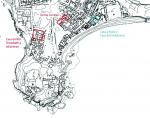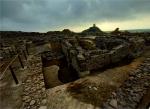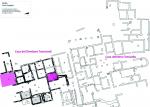Summary (English)
During this campaign carried out by Milan University, work continued on the excavation, study and enhancement of a large portion of Area E, the urban sector situated between the theatre and the Su Coluru headland. In particular, excavations took place in the Central Baths and the Casa del Direttore Tronchetti (fig. 1).
In the central Baths, known throughout the Mediterranean for its wonderful mosaics, excavation of the service rooms continued, in particular, in the area SW of the calidarium (SdT, fig.2) and in the large space behind the northern praefurnia (Tt- Tr, fig. 3). New levels relating to the use of the furnaces were uncovered, providing new data for the chronology of the complex’s construction phases. In the area of the “Casa del Direttore Tronchetti”, where work began in 2013, recent excavations followed two distinct lines of research: one concentrated on room O, in order to continue the diachronic analysis of the rooms arranged around the central atrium, and the other developed the open area excavation as far as room P, a large open space situated on the northern edge of the domus, in order to check the relationship with the surrounding quarter (fig. 4).
In synthesizing the data, it is useful to recall that the investigations undertaken in the large atrium A and adjacent rooms B, C, D and H have in recent years led to the identification of at least four occupation phases. The best-preserved structures belong to a large domus of the Severan period and subsequent phases of restructuring. However, it is clear that they overlay walls, floors and hydraulic structures relating to houses dating from the Augustan period onwards. In the NW corner of the excavation area, in particular in the vicinity of the so-called “pozzo nuragico”, several rooms belonging to a wealthy dwelling of early imperial date, the “House of the Well”, were demolished during the Severan restructuring, probably in a phase when there was a general reorganisation of the quarter, which culminated in the construction of the nearby Terme a Mare.
- Ilaria Frontori - Università degli Studi di Milano
Director
- Federica Chiesa, Università degli Studi di Milano
Team
- Francesco Giovinetti – Università degli Studi di Milano
- Giorgio Rea – Università degli Studi di Milano
- Gloria Bolzoni - Università degli Studi di Milano
- Luca Restelli - Università degli Studi di Milano
- Marco Emilio Erba – Università degli Studi di Milano
- Roberta Albertoni – Alma Mater Studiorum – Università di Bologna
- Ilaria Frontori - Università degli Studi di Milano
Research Body
- Università degli Studi di Milano, Dipartimento di Beni Culturali e Ambientali
Funding Body
- Università degli Studi di Milano, Dipartimento di Beni Culturali e Ambientali






![Download [PDF]](/excavation/skins/fasti/images/results/download_sml.png)

